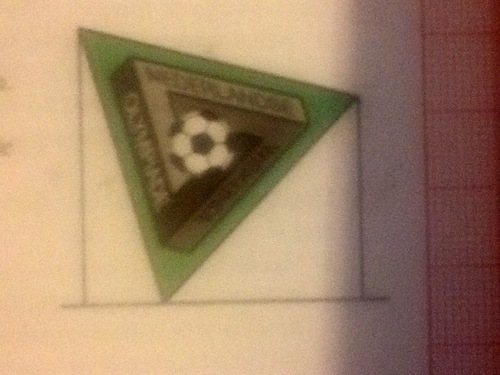Easy in form
 A flag in the form of an equilateral triangle is connected to the tops of 2 vertical poles. One of the pole has a length of 4 and the other pole has a length of 3. You also know that the third vertex touches the ground perfectly. Calculate the length of a side without the use of a calculator.
A flag in the form of an equilateral triangle is connected to the tops of 2 vertical poles. One of the pole has a length of 4 and the other pole has a length of 3. You also know that the third vertex touches the ground perfectly. Calculate the length of a side without the use of a calculator.
This section requires Javascript.
You are seeing this because something didn't load right. We suggest you, (a) try
refreshing the page, (b) enabling javascript if it is disabled on your browser and,
finally, (c)
loading the
non-javascript version of this page
. We're sorry about the hassle.
3 solutions
It can still be solved without a calculator or options just some trignometry.
Let d 1 be the distance between base point of the taller pole and flag's ground touch point, and let d 2 be the analogous distance for the other pole. Moreover let l be the length of a flag side. We get the system ⎩ ⎨ ⎧ l 2 − 1 = d 1 2 + d 2 2 + 2 d 1 d 2 l 2 − 1 6 = d 1 2 l 2 − 9 = d 2 2 Then one has l 2 − 1 = l 2 − 1 6 + l 2 − 9 + 2 ( l 2 − 1 6 ) ( l 2 − 9 ) 2 4 − l 2 = 2 ( l 2 − 1 6 ) ( l 2 − 9 ) 5 7 6 + l 4 − 4 8 l 2 = 4 ( l 2 − 2 5 l 2 + 1 4 4 ) = 4 l 2 − 1 0 0 l 2 + 5 7 6 l 2 − 4 8 = 4 l 2 − 1 0 0 3 l 2 = 5 2 l = 5 2 / 3
Here comes a long, long solution, based on Hector Flores' idea:
Call x and y the distances from the bases of the poles to the bottom vertex of the flag. Using pythagoras theorem we get three different equations, and they all describe the side of the triangle. These are:
x^2 + 16 and y^2 + 9 and (x+y)^2 + 1 We see that x^2 + 7 = y^2 Firstly, we want to break out y.
(x+y)^2 + 1 = X^2 + 16 // evolve and subtract x^2 2xy + y^2 + 1 = 16 // Substitute in x^2 + 7 and subtract 1 2xy + (x^2 + 7) = 15 // Subtract (x^2+ 7) 2xy = 8 - x^2 y =( 8 - x^2)/2x
Now, we shall substitute this into: x^2 + 16 = y^2 + 9
That gives us the following:
x^2 + 16 = [( 8 - x^2)/2x]^2 + 9 // now, clean up a bit
x^2 + 7 = (64 - 16x^2 + x^4)/4x^2 // and continue by multiplication with 4x^2
Prepare for pq
3x^4 + 44x^2 - 64 = 0
We now set x^2 = n
So:
3n^2 + 44n - 64 = 0
n^2 +( 44n/3) - 64/3 = 0
n = -22/3 + (484/9 + 252/9)^0.5) n = -22/3 + (676/9)^0.5 n = -22/3 + 26/3 = 4/3 x^2 = n = 4/3 x = 2/(3)^0.5
Put this into x^2 + 16 = y^2 + 9 4/3 + 48/3 = y^2 + 27/3 25/3 = y^2 y = 5/(3)^0.5
x + y = 7/(3)^0.5
Put this into (x+y)^2 + 1 =( triangel side)^2 And you shall get that the triangel side is (52/3)^0.5
I really need to learn to formate...
how does (x+y)^2+1 come from
The hypotenuse of any right triangle is greater than any of its legs, hence the side of the equilateral triangle is > 4 , or i.e. > 1 6
But the only test option that had the number under the root larger than 1 6 was 3 5 2 . No need to use a calculator.